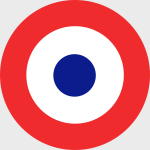Wings of the Great War WW19001 French Nieuport 17 Fighter - Lt. Charles Nungesser, Escadrille N. 65, No. 1895 (1:72 Scale)
"When you march into France, let the last man on the right brush the Channel with his sleeve."
General Alfred von Schlieffen, referring to the Schlieffen Plan just prior to his death in 1913
 The Nieuport 17 C.1 was a World War I French sesquiplane fighter designed by the Nieuport company. Its outstanding maneuverability and excellent rate of climb gave it a significant advantage when it entered service over all other fighters on both sides and as a result was widely used and enjoyed substantial production runs in France, Italy (Nieuport-Macchi) and Russia (Dux), eventually being used by every Allied power, and even being copied in Germany.
The Nieuport 17 C.1 was a World War I French sesquiplane fighter designed by the Nieuport company. Its outstanding maneuverability and excellent rate of climb gave it a significant advantage when it entered service over all other fighters on both sides and as a result was widely used and enjoyed substantial production runs in France, Italy (Nieuport-Macchi) and Russia (Dux), eventually being used by every Allied power, and even being copied in Germany.
The Nieuport 17 was a slightly larger development of the earlier Nieuport 16, with the same engine but larger wings and improved aerodynamic form. It was at first fitted with a 110 hp (82 kW) Le Rhone 9J engine, though later versions were upgraded to 120 or 130 hp (97 kW) engines.
Production of the new Alkan-Hamy synchronization gear permitted the wing mounted Lewis gun of the "11" to be supplemented with a synchronised Vickers gun mounted on the fuselage to fire through the propeller. The standard Royal Flying Corps synchroniser, the Vickers-Challenger gear, was unreliable, and in British service the Vickers was usually omitted, being armed instead with a Lewis on a Foster mounting, a curved metal rail which allowed the pilot to slide the gun back to change drums or clear jams. Some aircraft, particularly French, were fitted with both guns but a single machine gun was most common.
The Nieuport 21 differed in primarily using the lower powered 80 hp Le Rhine 9C and was intended as a fighter trainer or high altitude bomber escort, however it was used alongside the Nieuport 17 in the normal fighter roles in French and Russian service.
The Nieuport 23 differed from the 17 in only minor details, primarily centered around the use of a different machine gun synchronizer - possibly similar or identical to what was to be used on the later Nieuport 28 - which caused the gun to be offset and the fuel and oil tanks to be rearranged. Rear spar packing pieces were also redesigned. In service use, they were operated by both French and British squadrons alongside Nieuport 17s until replaced by Nieuport 24s.
Two triplanes based on the Nieuport 17 were built, one for testing by the French and the other by the British. The narrow chord wings were staggered in an unusual manner, with the middle wing furthest forward and the top wing furthest aft. No orders resulted, although Nieuport trialed the same layout on a Nieuport 17bis which was tested by the British as well, with no more success. Both types had good climbing characteristics but were tail heavy.
The high aspect ratio lower wing which made the Nieuport 17 a sesquiplane (literally "one-and-a-half wings"), and which helped give it an impressive climb rate, was unable to sustain very high speeds without encountering flutter, which was encountered occasionally during sustained power on dives and some aircraft lost their lower wings as a result. It was misunderstood at the time, and also caused of the loss of several monoplanes - a problem that existed back to the pioneer-era pre-war Bleriot XI and other monoplane designs from before the war - which led to the RFC monoplane ban. British Nieuports were strengthened with modifications at No 2 Aeroplane Supply Depot, while training, and replacing the lower wings with those from Nieuport 24s at French squadrons helped reduce the danger.
Several Berliner Helicopters were built around Nieuport 23 fuselages including the 1922 and 1923 versions.
Pictured here is a 1:72 scale replica of a French Nieuport 17 fighter that was piloted by Lt. Charles Nungesser, who was attached to Escadrille N. 65. Sold Out!
Dimensions:
Length: 3-1/4-inches
Wingspan: 4-3/4-inches
Release Date: April 2016
Historical Account: "Flying Solo" - Charles Eugene Jules Marie Nungesser, MC (March 15th, 1892 - presumably on or after May 8th, 1927) was a French ace pilot and adventurer, best remembered as a rival of Charles Lindbergh. Nungesser was a renowned ace in France, rating third highest in the country for air combat victories during World War I.
After the war, Nungesser mysteriously disappeared on an attempt to make the first non-stop transatlantic flight from Paris to New York, flying with wartime comrade Francois Coli in The White Bird (L'Oiseau Blanc). Their aircraft took off from Paris on May 8th, 1927, was sighted once more over Ireland, and then was never seen again. The disappearance of Nungesser is considered one of the great mysteries in the history of aviation, and modern speculation is that the aircraft was either lost over the Atlantic or crashed in Newfoundland or Maine. Two weeks after Nungesser and Coli's attempt, Charles Lindbergh successfully made the journey, flying solo from New York to Paris in Spirit of St. Louis. Monuments and museums honoring Nungesser and Coli's attempt exist at Le Bourget airport in Paris and on the cliffs of Etretat, the location from which their plane was last sighted in France.


